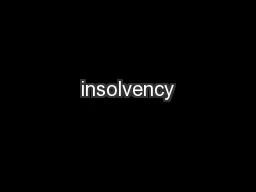

insolvency When liabilities exceed assets Only legally insolvent when sequestrated by order of court sequestration A sequestration order is a formal declaration that a debtor is insolvent The order is granted at ID: 545861
Download Presentation The PPT/PDF document "insolvency" is the property of its rightful owner. Permission is granted to download and print the materials on this web site for personal, non-commercial use only, and to display it on your personal computer provided you do not modify the materials and that you retain all copyright notices contained in the materials. By downloading content from our website, you accept the terms of this agreement.
Slide1
insolvency
Slide2
insolvency
When liabilities exceed assets
Only legally insolvent when sequestrated by order of courtSlide3
sequestration
A sequestration order is a formal declaration that a debtor is insolvent. The order is granted at
the request
of the debtor himself (voluntary) or at the request of one or more of his
creditors (compulsory
).Slide4
Purpose of sequestration
The main purpose of a sequestration order is to ensure the orderly and
equitable distribution
of a debtors assets where they are insufficient to meet the claims of all his creditors.Slide5
Voluntary sequestration
Requirements:
The
insolvent must comply with the prescribed formalities. These formalities pertain
mainly to
notification of creditors and other interested parties. The purpose of this is to enable
the creditors
to object to the application.
The debtor has to prove that he is in fact insolvent.
The surrender must be to the advantage of the creditors.
There must be sufficient assets to cover the costs
of sequestration
.Slide6
Compulsory
Brought by a creditor with a liquidated claim of at least R100
Creditor must prove:
He has established a claim that entitles him to apply for
the sequestration
of the
debtors estate
The debtor has committed an act of insolvency or is insolvent
There is reason to believe that sequestration will be to the advantage to the creditor.Slide7
Acts of insolvency
The debtor leaves the Republic or is absent from the Republic or departs from
his house
with the intention to evade or delay payment of his debts.
Failure to satisfy judgment. If a court has given judgment against him, and he fails
to satisfy
the judgment due to insufficient property.
If the insolvent makes, or attempts making any disposition of any of his
property which
has, or would have, the effect of prejudicing his creditors or of preferring
one creditor
above another.Slide8
Acts of insolvency
If he removes, or attempts to remove, any of his property with an intention
to prejudice
his creditors or to prefer one creditor above another.
If the insolvent makes, or offers to make, any arrangements with any of his
creditors to
release him wholly or in part from his debts.
Failure to apply for surrender. If after having published a notice of surrender of
his estate
which has not yet lapsed or been withdrawn, fails to submit a
substantively correct
and complete statement of affairs with the Master, or fails to apply
for acceptance
of the surrender of the estate on the date indicated by the noticeSlide9
Acts of insolvency
Notice of inability to pay. If the debtor gives notice in writing to any one of
his creditors
that he is unable to pay any of his debts.
Inability to pay debts after notice of transfer of business. If, being a trader, he
gives notice
in the Gazette of his intention to transfer his business and is therefore
unable to
pay all of his debts.Slide10
Effect of sequestration on property
The sequestration of a person’s estate causes the insolvent estate to vest in the Master of
the High
Court and then in the trustee as soon as one is appointed to him. However,
clothes, bedding
and other essential means of substance remain in the hands of the insolvent.
Remuneration for work done by him after sequestration, pension monies, compensation
for damages
suffered by him in his personal capacity, mean damages as a result of bodily
injury or
infringement of his personality.Slide11
Effects of sequestration
All civil proceedings stayed until trustee appointed
May not serve as director
Contracts – trustee to decideSlide12
Voidable dispositions
Trustee can set aside if liabilities exceed assets afterwards
Not for value
Prefer one creditor over another
Undue preference – intended to prefer one creditor
Voidable preference – if within 6 months of insolvencySlide13
Creditors meetings
First meeting – prove claims, elect trustee, interrogate
2
nd
meeting – prove claims, interrogate, trustee reports back, creditors instruct
Additional meetings as necessarySlide14
Submitting of claims
On affidavit with supporting documents
Only proven claims can share in proceeds
Danger of contributionSlide15
distribution
Secured creditors – mortgage, pawn, lien
Preferred creditors – notarial bond, tax, wages
etc
Concurrent – share in free residue